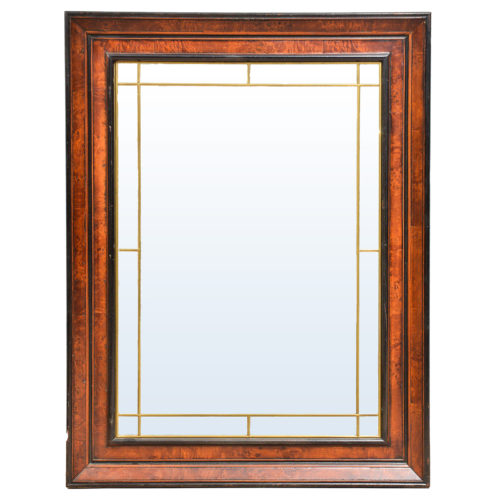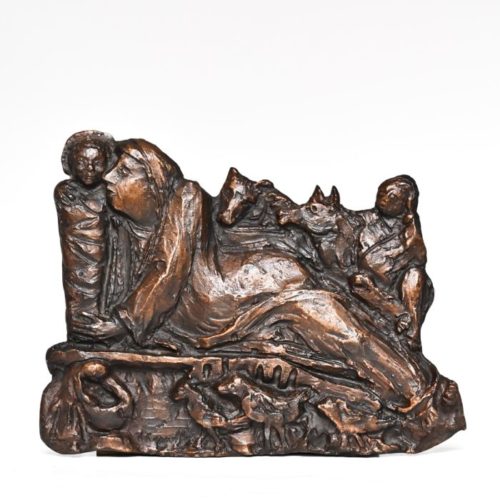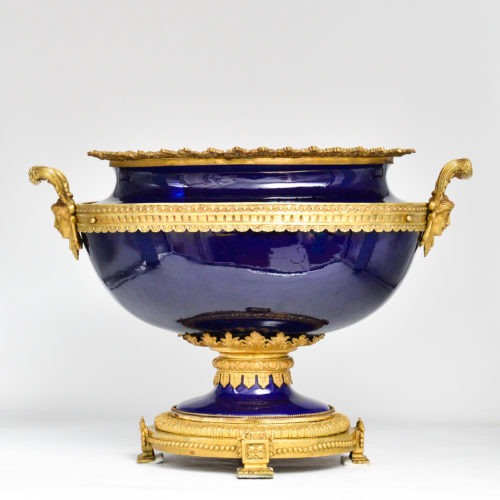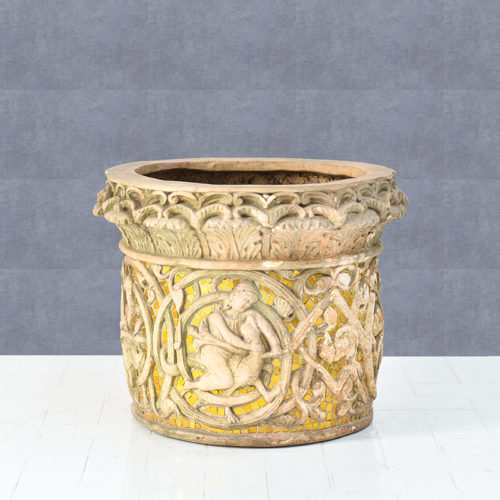-
Out of stock
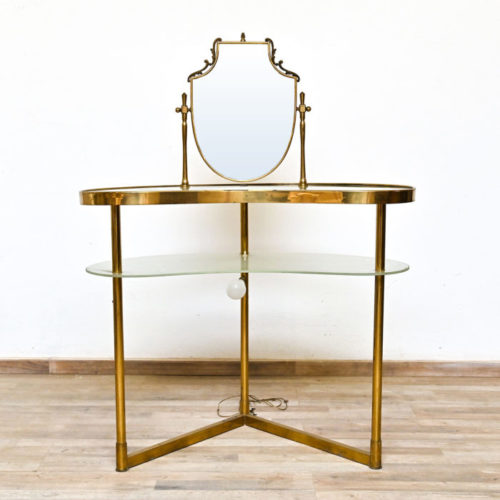 Brass-plated iron bedroom toilet from the 1950s, with lighting on the lower level. The two floors are bean-shaped. Period: 1950s Measurements: H 120 x W 91 x D 49 cm
Brass-plated iron bedroom toilet from the 1950s, with lighting on the lower level. The two floors are bean-shaped. Period: 1950s Measurements: H 120 x W 91 x D 49 cm -
Out of stock
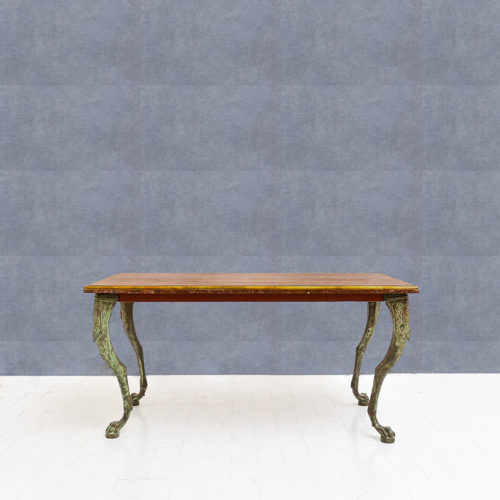 Period: 1920s Measurements: H 49.5 x L 100.5 x P 50 cmPeculiar coffee table, four-legged bronze base, greyhound paw shape, masks and decorations. Marble top.
Period: 1920s Measurements: H 49.5 x L 100.5 x P 50 cmPeculiar coffee table, four-legged bronze base, greyhound paw shape, masks and decorations. Marble top. -
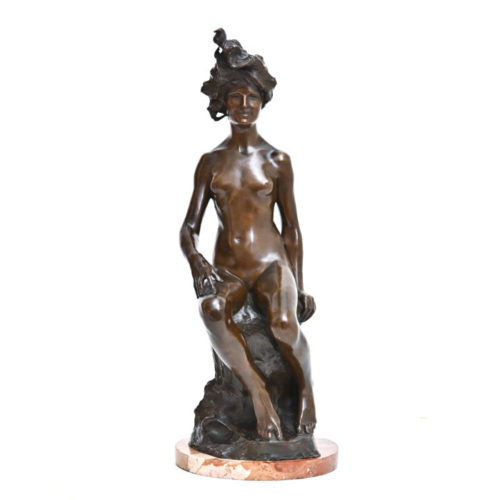 Bronze by Giovanni Nicolini, work of the 1920s / 1930s. Giovanni Nicolini was born in Palermo on April 14, 1872. He died in Rome in 1956. In the 1920s / 1930s the author focused his formal research on the theme of the nude figure, giving life to works strongly expressive of feelings or passions, in which the female figure with floating hair and enveloping shapes revealed a strong art nouveau influence. Period: 1920s / 30s Measurements: H with base 51 cm / H 49 x Ø base 19 cm
Bronze by Giovanni Nicolini, work of the 1920s / 1930s. Giovanni Nicolini was born in Palermo on April 14, 1872. He died in Rome in 1956. In the 1920s / 1930s the author focused his formal research on the theme of the nude figure, giving life to works strongly expressive of feelings or passions, in which the female figure with floating hair and enveloping shapes revealed a strong art nouveau influence. Period: 1920s / 30s Measurements: H with base 51 cm / H 49 x Ø base 19 cm -
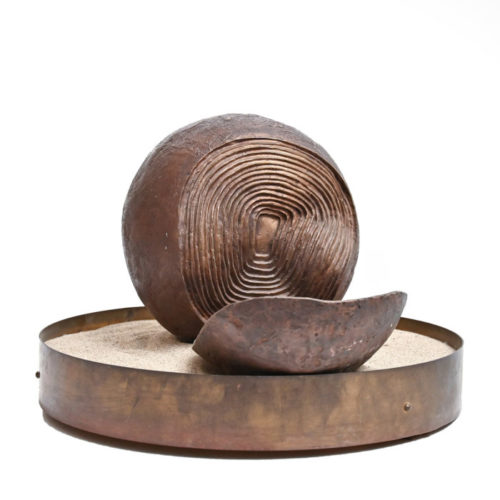 Period: 1976 Measurements: H32 x W48 x W48 cmBronze sculpture by Franco Zazzeri signed and dated 1976. "A sphere, and all of a sudden it breaks, a slice of it caught just in the moment of falling down (...) that sphere is configured as the earth that turns in spaces; what will become the segment that has detached from the sphere of Zazzeri? " - Marco Valsecchi 1977 (Milan, 1913 - 1980) - art critic, university professor, essayist and journalist of the daily newspapers Il Giorno and Il Giornale and of the weekly Lo Speciale. "Zazzeri's work can be called" totemism of the origins ": an anthropological function that rediscovers the notion of beauty in the recognition of an inner and eternal truth." - Riccardo Barletta 1985 - Modern art critic and professor of history of design at the Polytechnic School of Milan. "Cosmos and Logos are converted into each other, through the filter of the protean personality of Zazzeri" - Floriano De Santi 1999 - Artistic Director and Critic and art historian FRANCO ZAZZERI was born in Florence on 19 August 1938. He spent his childhood in Monte San Savino, Arezzo. At the age of fourteen he began working in a ceramics workshop but, fascinated by sculpture, he moved to Arezzo where he worked for a local marble worker and attended the Aretina art school under the guidance of the sculptor Giovanni Bianchi. At the end of the 1950s, commissioned by various personalities from Arezzo, he made several sculptural portraits; he wins the competition for the construction of the statue of the Madonna delle Vertighe (patron saint of the Autostrada del Sole). In 1960 he moved to Milan (where he currently lives and works). In the same year he graduated from the school of the Castello Sforzesco sculpture section. To his credit 30 personal exhibitions held in Italy and Europe. Numerous group exhibitions; we cite some of the most prestigious: 1983 "Italian sculpture in the world" traveling exhibition in the main cities of the world by the Ministry of Foreign Affairs and the Rome Quadrennial of Art; 1984 "XXIX Biennale of Art of the City of Milan", Palazzo della Permanente; 1986 "XLII International Biennial of Art of Venice"; 1989 "XXXI Biennale of Art of the City of Milan", Palazzo della Permanente; 1999 "XIII Quadrennial of Rome". Some of his sculptures are found in: Montecarlo - Banque de Gestion Monegasque; Rome - EUR - Italian Credit; Rome - via del corso 374 - Credito Italiano; Turin - in via Arsenale, 11 - Credito Italiano; Moscow - Italian Representation; Milan - Linate and Malpensa Airport; Milan - Municipality of Milan in via Pirelli; Milan - Piazza Duca d'Aosta; Milan - Civic Center - via Oglio 18; Here below we mention only a few other exhibitions, by importance and artistic significance: 2002 Milan, Palazzo Municipale Sondrio; 1995-1999-2005 Milan, Borgogna Gallery; 1989 Monte San Savino, "Homage to Sansovino"; 1984 Munich, Galerie Museum BMW; 1984 Vienna, Italian Cultural Institute; 1980 Ferrara, Palazzo Dei Diamanti; 1975-1979-1983 Ada Zunino Gallery; 1971-1974 Monza, Arengario Museum; 1970-1971-1972-1973 Milan, 'La Darsena' Gallery. "... Starting from a figurative sculpture Franco Zarreri soon turns to a more informal vision of the figure, a non-individual content emerges from the representation of the individual to that of the group, the family nucleus, seen as a reality of the primordium in a genetic sense . A non-descriptive and unrealistic position. ... " from "Zarreri - The Totemism of Origins" Riccardo Barletta ed. Milan Point and Line
Period: 1976 Measurements: H32 x W48 x W48 cmBronze sculpture by Franco Zazzeri signed and dated 1976. "A sphere, and all of a sudden it breaks, a slice of it caught just in the moment of falling down (...) that sphere is configured as the earth that turns in spaces; what will become the segment that has detached from the sphere of Zazzeri? " - Marco Valsecchi 1977 (Milan, 1913 - 1980) - art critic, university professor, essayist and journalist of the daily newspapers Il Giorno and Il Giornale and of the weekly Lo Speciale. "Zazzeri's work can be called" totemism of the origins ": an anthropological function that rediscovers the notion of beauty in the recognition of an inner and eternal truth." - Riccardo Barletta 1985 - Modern art critic and professor of history of design at the Polytechnic School of Milan. "Cosmos and Logos are converted into each other, through the filter of the protean personality of Zazzeri" - Floriano De Santi 1999 - Artistic Director and Critic and art historian FRANCO ZAZZERI was born in Florence on 19 August 1938. He spent his childhood in Monte San Savino, Arezzo. At the age of fourteen he began working in a ceramics workshop but, fascinated by sculpture, he moved to Arezzo where he worked for a local marble worker and attended the Aretina art school under the guidance of the sculptor Giovanni Bianchi. At the end of the 1950s, commissioned by various personalities from Arezzo, he made several sculptural portraits; he wins the competition for the construction of the statue of the Madonna delle Vertighe (patron saint of the Autostrada del Sole). In 1960 he moved to Milan (where he currently lives and works). In the same year he graduated from the school of the Castello Sforzesco sculpture section. To his credit 30 personal exhibitions held in Italy and Europe. Numerous group exhibitions; we cite some of the most prestigious: 1983 "Italian sculpture in the world" traveling exhibition in the main cities of the world by the Ministry of Foreign Affairs and the Rome Quadrennial of Art; 1984 "XXIX Biennale of Art of the City of Milan", Palazzo della Permanente; 1986 "XLII International Biennial of Art of Venice"; 1989 "XXXI Biennale of Art of the City of Milan", Palazzo della Permanente; 1999 "XIII Quadrennial of Rome". Some of his sculptures are found in: Montecarlo - Banque de Gestion Monegasque; Rome - EUR - Italian Credit; Rome - via del corso 374 - Credito Italiano; Turin - in via Arsenale, 11 - Credito Italiano; Moscow - Italian Representation; Milan - Linate and Malpensa Airport; Milan - Municipality of Milan in via Pirelli; Milan - Piazza Duca d'Aosta; Milan - Civic Center - via Oglio 18; Here below we mention only a few other exhibitions, by importance and artistic significance: 2002 Milan, Palazzo Municipale Sondrio; 1995-1999-2005 Milan, Borgogna Gallery; 1989 Monte San Savino, "Homage to Sansovino"; 1984 Munich, Galerie Museum BMW; 1984 Vienna, Italian Cultural Institute; 1980 Ferrara, Palazzo Dei Diamanti; 1975-1979-1983 Ada Zunino Gallery; 1971-1974 Monza, Arengario Museum; 1970-1971-1972-1973 Milan, 'La Darsena' Gallery. "... Starting from a figurative sculpture Franco Zarreri soon turns to a more informal vision of the figure, a non-individual content emerges from the representation of the individual to that of the group, the family nucleus, seen as a reality of the primordium in a genetic sense . A non-descriptive and unrealistic position. ... " from "Zarreri - The Totemism of Origins" Riccardo Barletta ed. Milan Point and Line -
Out of stock
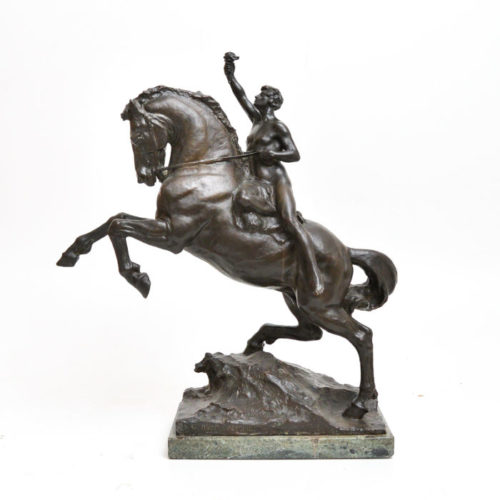 Bronze sculpture by Giacomo Buzzi Reschini (Viggiù, 4 September 1881 - Turin, 18 September 1962) dating back to the early 1900s. GIACOMO BUZZI RESCHINI The son of a marble craftsman, he went to Turin at a very young age to attend the Albertina Academy under the guidance of Luigi Belli first and then Leonardo Bistolf; however, he soon left school to open his own studio. In Turin he received awards and honors: in 1909 he made two medallions and presented the works "Non omnis moriar", "Vanaexpected", "Stella Alpina" (purchased by King Vittorio Emanuele III) at the Exhibition of Fine Arts, while in 1911 he received the gold medal for two equestrian groups. After the First World War, Buzzi Reschini resumed his activity by becoming friends with Canonica, Calandra, Bistolf, Pogliaghi and Enrico Butti, his fellow citizen. Buzzi Reschini was a brilliant artist: if his entire production is qualified by adhering to the romantic theme, liberty implications prevail in the works of the beginning of the century, while later he moved towards more sober and monumental forms, typical of the years of the "twentieth century". Of his vast production, we remember: "The Immaculate Conception" (1928), in travertine, with a height of 5 m, for the Palazzo del Governorato of the Vatican City; "Saints Cyril and Methodius" for the Bohemian College in Rome; "the War Memorial of Chieri" (1925), of Croce Mosso, of Bordighera, of San Damiano d’Asti (1927) and of Agliè; "the Four Prophets" (post 1930) for the facade of the church of the Annunciata in Turin, for which he also painted the Angels of the interior and the doors with Stories of the Virgin. "the Supreme Judgment" in the Monumental Cemetery of Milan, later destroyed in a bombing in 1943; "The last kiss" for the Monumental Cemetery of Vercelli; "The three Marys"," The Mass of the Dead"," Maternity"," S. Sebastiano"," La Pietà", "S. Francesco" for the Turin Cemetery; "The guards at the sepulcher" (1957). In the 1960s, next to the Butti Museum in Viggiù, he built a new pavilion with the intention of hosting his own plaster cast gallery and the plaster casts of other members of the Viggiutese sculpture of the twentieth century. His models are in fact set up in the central hall and in room II of the building.Period: Early 1900s Measurements: H 78 x W 69 x D 23 cm
Bronze sculpture by Giacomo Buzzi Reschini (Viggiù, 4 September 1881 - Turin, 18 September 1962) dating back to the early 1900s. GIACOMO BUZZI RESCHINI The son of a marble craftsman, he went to Turin at a very young age to attend the Albertina Academy under the guidance of Luigi Belli first and then Leonardo Bistolf; however, he soon left school to open his own studio. In Turin he received awards and honors: in 1909 he made two medallions and presented the works "Non omnis moriar", "Vanaexpected", "Stella Alpina" (purchased by King Vittorio Emanuele III) at the Exhibition of Fine Arts, while in 1911 he received the gold medal for two equestrian groups. After the First World War, Buzzi Reschini resumed his activity by becoming friends with Canonica, Calandra, Bistolf, Pogliaghi and Enrico Butti, his fellow citizen. Buzzi Reschini was a brilliant artist: if his entire production is qualified by adhering to the romantic theme, liberty implications prevail in the works of the beginning of the century, while later he moved towards more sober and monumental forms, typical of the years of the "twentieth century". Of his vast production, we remember: "The Immaculate Conception" (1928), in travertine, with a height of 5 m, for the Palazzo del Governorato of the Vatican City; "Saints Cyril and Methodius" for the Bohemian College in Rome; "the War Memorial of Chieri" (1925), of Croce Mosso, of Bordighera, of San Damiano d’Asti (1927) and of Agliè; "the Four Prophets" (post 1930) for the facade of the church of the Annunciata in Turin, for which he also painted the Angels of the interior and the doors with Stories of the Virgin. "the Supreme Judgment" in the Monumental Cemetery of Milan, later destroyed in a bombing in 1943; "The last kiss" for the Monumental Cemetery of Vercelli; "The three Marys"," The Mass of the Dead"," Maternity"," S. Sebastiano"," La Pietà", "S. Francesco" for the Turin Cemetery; "The guards at the sepulcher" (1957). In the 1960s, next to the Butti Museum in Viggiù, he built a new pavilion with the intention of hosting his own plaster cast gallery and the plaster casts of other members of the Viggiutese sculpture of the twentieth century. His models are in fact set up in the central hall and in room II of the building.Period: Early 1900s Measurements: H 78 x W 69 x D 23 cm -
 Bronze Sculpture by Torquato Tamagnini (1886-1965), depicting "Woman in Torsion", signed at the bottom on the base. He was a sculptor who was particularly famous for the numerous monuments to the fallen of the Great War. Author of some small bronzes of Liberty taste. Present at the I Biennale Romana, he founded the Casa d'Arte "Corinthia" in Rome. In excellent condition. Period: Early 20th century. Measurements: H 57 x L 25,5 x P 22 cm
Bronze Sculpture by Torquato Tamagnini (1886-1965), depicting "Woman in Torsion", signed at the bottom on the base. He was a sculptor who was particularly famous for the numerous monuments to the fallen of the Great War. Author of some small bronzes of Liberty taste. Present at the I Biennale Romana, he founded the Casa d'Arte "Corinthia" in Rome. In excellent condition. Period: Early 20th century. Measurements: H 57 x L 25,5 x P 22 cm -
Out of stock
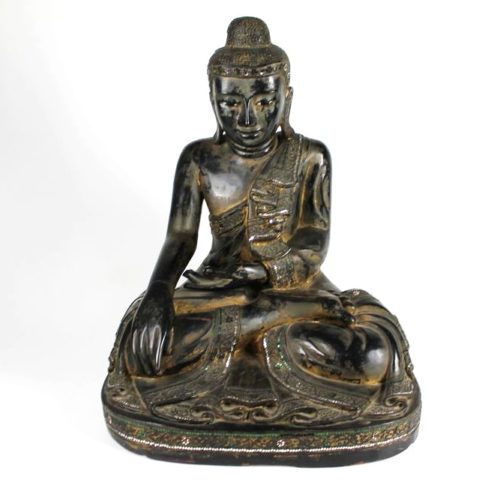 Buddha, ancient wooden sculpture, Oriental art dated 1800. Very good condition.Period: 1800 Measurements: H 60 x L 45 x P 38 cm
Buddha, ancient wooden sculpture, Oriental art dated 1800. Very good condition.Period: 1800 Measurements: H 60 x L 45 x P 38 cm
